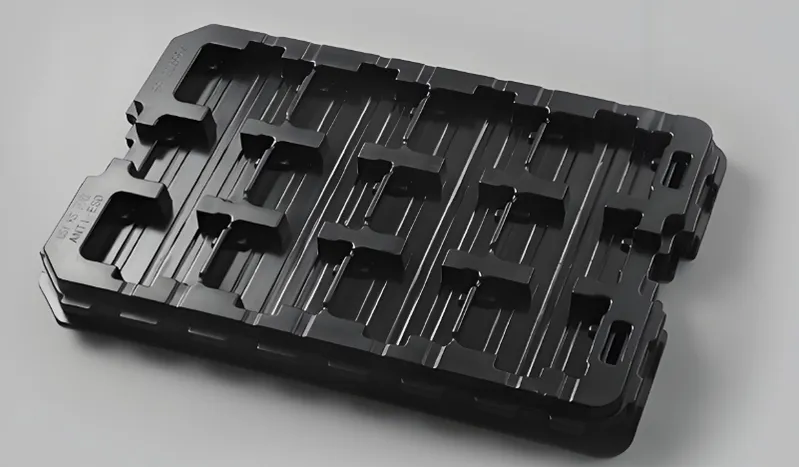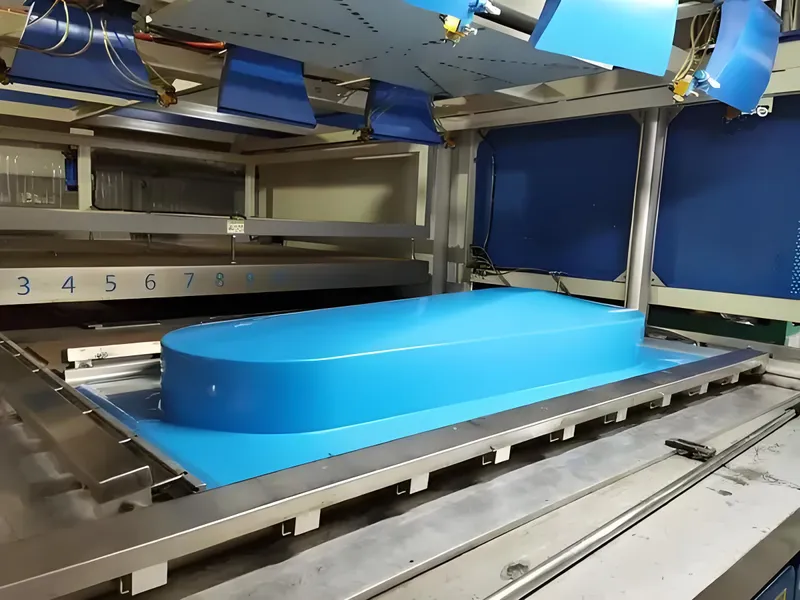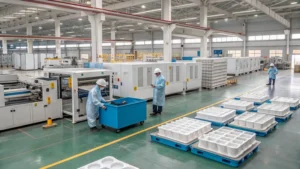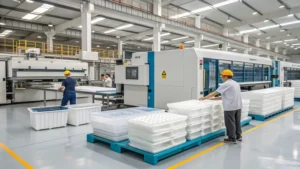
The thermoforming process creates custom-shaped plastic parts by heating a thermoplastic sheet and forming it over a mold using vacuum or pressure, followed by cooling to set the shape. Cycle time1, the total duration from loading the sheet to unloading the formed part, is a critical factor in production efficiency, especially in industries like packaging, automotive, and medical devices.
Cycle time in thermoforming is determined by sheet thickness, material type, heating and cooling methods, mold design, and part geometry, all of which impact production speed and cost efficiency.
Understanding these factors is essential for optimizing thermoforming operations and reducing costs while maintaining quality. Explore further to see how each element influences cycle time and how you can leverage this knowledge for your production needs.
Cycle time is the most critical factor in thermoforming efficiency.True
Shorter cycle times allow for higher production rates, reducing costs and increasing output, especially in high-volume industries.
All thermoforming processes have the same cycle time regardless of material or design.False
Cycle time varies significantly based on factors like material properties, sheet thickness, and mold design.
What are the Key Factors Affecting Cycle Time in Thermoforming?
Cycle time in thermoforming is influenced by several critical factors that determine how quickly a part can be produced while maintaining quality.

Key factors include sheet thickness, material type, heating and cooling methods, mold design, and part geometry, each impacting the heating, forming, and cooling stages.
| Factor | Impact on Cycle Time |
|---|---|
| Sheet Thickness2 | Thicker sheets increase heating and cooling times |
| Material Type | Materials with higher thermal conductivity heat and cool faster |
| Heating Method | Efficient heating systems (e.g., radiant or convective) reduce heating time |
| Cooling Method | Water-cooled molds can reduce cooling time by up to 10 times compared to air-cooled |
| Mold Design | Aluminum molds with cooling channels enhance cooling efficiency |
| Part Geometry | Complex shapes may require longer forming and cooling times |
Sheet Thickness
Thicker sheets take longer to heat uniformly and cool down, directly extending cycle time. For example, heavy gauge thermoforming3 (sheets >0.25 cm) typically has longer cycle times than thin gauge due to increased heating and cooling requirements.

Material Type
Different thermoplastics have varying thermal properties4. Materials like polystyrene (PS) and polyethylene terephthalate (PET) have different forming temperatures and thermal conductivities, affecting how quickly they heat and cool. For instance, PET requires higher forming temperatures (160-210°C) compared to PS (150-200°C), potentially increasing heating time.
Heating Methods
Efficient heating systems, such as radiant or convective heating, can significantly reduce heating time. Advanced systems ensure uniform heating, preventing delays from uneven temperature distribution.
Cooling Methods
Cooling is often the most time-consuming stage. Water-cooled molds, especially those made of aluminum, can cool parts up to 10 times faster than uncooled steel molds, drastically reducing cycle time.

Mold Design
Mold material and design play a crucial role. Aluminum molds with integrated cooling channels allow for faster heat dissipation compared to steel molds. Additionally, molds designed for uniform cooling prevent warping and reduce cycle time.
Part Geometry
Complex part geometries, such as deep draws or intricate details, may require longer forming and cooling times to ensure uniform shaping and avoid defects like warping or thinning.
Cooling time is often the most significant part of the cycle time in thermoforming.True
Cooling can account for up to 50-70% of the total cycle time, especially in heavy gauge applications where parts are thicker.
Material selection has no impact on cycle time.False
Different materials have unique thermal properties that directly affect heating and cooling rates, thus influencing cycle time.
How Do These Factors Interact in the Thermoforming Process?
The factors influencing cycle time are interconnected, and changes in one can affect others, making optimization a balancing act.
Sheet thickness, material type, and part geometry influence heating and cooling requirements5, while mold design and process methods directly impact efficiency.

Interaction Between Sheet Thickness and Heating/Cooling
Thicker sheets not only require more time to heat but also to cool. For instance, a 0.5 cm thick sheet may take twice as long to heat and cool compared to a 0.25 cm sheet, significantly extending cycle time.
Material Type and Process Methods
Materials with higher thermal conductivity, like polypropylene (PP), may heat and cool faster than those with lower conductivity, such as polylactic acid (PLA). However, semi-crystalline materials like PP may require slower cooling to achieve desired crystallinity, potentially extending cycle time.

Mold Design and Part Geometry
Complex part geometries often necessitate specific mold designs, such as deeper molds or additional cooling channels, which can affect cooling efficiency. For example, a part with deep draws may require a mold with more intricate cooling systems to ensure uniform cooling, potentially increasing cycle time.
Optimizing one factor always leads to reduced cycle time.False
Improving one factor, like using a thinner sheet, may require adjustments in other areas, such as material selection or mold design, to maintain quality.
Advanced mold designs can reduce cycle time by up to 50%.True
Molds with integrated cooling channels and made from materials like aluminum can significantly enhance cooling efficiency, cutting cycle time.
What are the Steps in the Thermoforming Process Affecting Cycle Time?
The thermoforming process consists of several stages, each contributing to the overall cycle time, with heating and cooling being the most time-intensive.
The process includes loading, heating, forming, cooling, and unloading, with heating and cooling stages being the primary determinants of cycle time.

Loading the Sheet
This step is typically quick, often automated, and has minimal impact on cycle time.
Heating the Sheet
The sheet is heated to its forming temperature, which varies by material. Heating time depends on sheet thickness, material type, and the efficiency of the heating system. For example, single-sided heating is limited to thinner sheets (~1 mm), while thicker sheets require double-sided heating, increasing time.
Forming the Sheet
The heated sheet is formed over the mold using vacuum, pressure, or mechanical force. This step is relatively fast, often taking only seconds, but can be influenced by part complexity and forming method (e.g., plug-assisted forming for deeper draws).

Cooling the Formed Part
Cooling is critical and often the longest stage. The part must cool sufficiently to set its shape without warping. Cooling time is affected by part thickness, material properties, mold design6, and cooling method. Water-cooled aluminum molds can significantly reduce this time.
Unloading the Formed Part
Like loading, unloading is typically quick and has little impact on overall cycle time.
Forming is the most time-consuming stage in thermoforming.False
Forming is usually quick; heating and cooling dominate cycle time, especially in heavy gauge applications.
Efficient cooling methods can drastically reduce cycle time.True
Water-cooled molds can cool parts up to 10 times faster than air-cooled systems, significantly cutting cycle time.
How Can You Optimize Cycle Time in Thermoforming?
Optimizing cycle time involves balancing production speed with part quality by carefully selecting materials, designs, and process parameters.
Use thinner sheets, select materials with favorable thermal properties, invest in efficient heating and cooling systems, and design molds for optimal cooling to reduce cycle time.

Tips for Optimization
-
Minimize Sheet Thickness: Use the thinnest sheet possible that meets product requirements to reduce heating and cooling times.
-
Select Materials Wisely: Choose materials with higher thermal conductivity and lower forming temperatures to speed up heating and cooling.
-
Invest in Advanced Heating Systems: Use efficient heating methods like radiant or convective heating for uniform and faster heating.
-
Use Water-Cooled Molds: Aluminum molds with integrated cooling channels can significantly reduce cooling time.
-
Simplify Part Geometry: Design parts with simpler shapes to ensure uniform heating and cooling, reducing the risk of defects and time delays.
Reducing sheet thickness always improves cycle time without drawbacks.False
Thinner sheets may compromise part strength or durability, requiring a balance between thickness and performance.
Investing in advanced cooling systems is cost-effective for high-volume production.True
The initial investment in water-cooled molds can be offset by increased production speed and reduced cycle times.
Conclusion
Cycle time in thermoforming is influenced by a complex interplay of factors, including sheet thickness, material type, heating and cooling methods, mold design, and part geometry. Understanding these factors and their interactions is crucial for optimizing production efficiency and reducing costs. By carefully selecting materials, investing in advanced process technologies, and designing for efficiency, manufacturers can achieve faster cycle times without sacrificing quality.
-
Understanding cycle time is crucial for optimizing production efficiency and reducing costs in thermoforming processes. ↩
-
Exploring the impact of sheet thickness can help you make informed decisions to enhance production speed and efficiency. ↩
-
Understanding heavy gauge thermoforming can help optimize production efficiency and reduce cycle times in manufacturing processes. ↩
-
Exploring thermal properties can enhance material selection and processing strategies for better performance in manufacturing. ↩
-
Heating and cooling are key stages in production. Discover how they impact efficiency and cycle time by exploring this resource. ↩
-
Mold design plays a vital role in production efficiency. Learn about its significance and how it affects cycle time by checking this link. ↩








